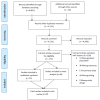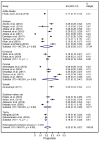The Magnitude of NCD Risk Factors in Ethiopia: Meta-Analysis and Systematic Review of Evidence
- PMID: 35564716
- PMCID: PMC9106049
- DOI: 10.3390/ijerph19095316
The Magnitude of NCD Risk Factors in Ethiopia: Meta-Analysis and Systematic Review of Evidence
Abstract
Background: Non-communicable Diseases (NCDs) and their risk factors are the leading contributors to morbidity and mortality globally, particularly in low- and middle-income countries including Ethiopia. To date, there has been no synthesis of the literature on the relative prevalence of NCD risk factors in Ethiopia.
Methodology: We conducted a systematic review and meta-analysis of primary studies reporting on the prevalence of NCD risk factors in Ethiopia published in English from 2012 to July 2020. Pre-tested NCD search terms were applied to Medline, Embase, Scopus, CINAHL, and Global Health. Three reviewers screened and appraised the quality of the identified papers. Data extraction was conducted using a pilot tested proforma. Meta-analysis was conducted using Stata 16 and pooled prevalence estimated with associated 95% confidence intervals. Clinically heterogeneous studies that did not fulfil the eligibility criteria for meta-analysis were narratively synthesised. I2 was used to assess statistical heterogeneity.
Results: 47 studies fulfilled the inclusion criteria and contributed 68 NCD risk factor prevalence estimates. Hypertension was the most frequently examined NCD risk factor, with a pooled prevalence of 21% (n = 27 studies). The pooled prevalence percentages for overweight and obesity were 19.2% and 10.3%, respectively (n = 7 studies each), with a combined prevalence of 26.8% (n = 1 study). It was not possible to pool the prevalence of alcohol consumption, smoking, metabolic disorders, or fruit consumption because of heterogeneity across studies. The prevalence of alcohol use, as reported from the included individual studies, ranged from 12.4% to 13.5% (n = 7 studies). More than 90% of participants met the WHO-recommended level of physical activity (n = 5 studies). The prevalence of smoking was highly variable, ranging between 0.8% and 38.6%, as was the prevalence of heavy alcohol drinking (12.4% to 21.1%, n = 6 studies) and metabolic syndrome (4.8% to 9.6%, n = 5 studies). Fruit consumption ranged from 1.5% up to the recommended level, but varied across geographic areas (n = 3 studies).
Conclusion and recommendations: The prevalence of NCD risk factors in Ethiopia is relatively high. National NCD risk factor surveillance is required to inform the prioritisation of policies and interventions to reduce the NCD burden in Ethiopia.
Keywords: Ethiopia; NCD; hypertension; overweight; risk factors.
Conflict of interest statement
The authors declare that they have no competing interests.
Figures





References
-
- WHO Noncommunicable Diseases: WHO 2018. [(accessed on 25 January 2022)]. Available online: https://www.who.int/news-room/fact-sheets/detail/noncommunicable-diseases.
Publication types
MeSH terms
LinkOut - more resources
Full Text Sources
Miscellaneous

